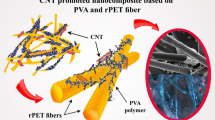Abstract
The aim of this work was to investigate the possibility of using non-woven materials (NWM) from waste fibers for oil spill cleanup and their subsequent recovery. Manufacture of textile and readymade products generates a significant amount of solid waste. A major part of it is deposited in landfills or disposed of uncontrollably. This slowly degradable waste causes environmental problems. In the present study are used two types of NWM obtained by methods where waste fibers are utilized. Thus, real textile products are produced (blankets) with which spills are covered and removed by adsorption. These products are produced by two methods: the strengthening of the covering from recovered fibers is made by entanglement when needles of special design pass through layers (needle-punching) or by stitching with thread (technology Maliwatt). Regardless of the random nature of the fiber mixture, the investigated products are good adsorbents of petroleum products. The nature of their structure (a significant void volume and developed surface) leads to a rapid recovery of the spilled petroleum products without sinking of the fiber layer for the sampled times. The used NWM can be burned under special conditions.










Similar content being viewed by others
References
Aboul-Gheit AK, Khalil FH, Abdel-Moghny T (2006) Adsorption of spilled oil from seawater by waste plastic. Oil Gas Sci Technol Rev IFP 61:259–268. https://doi.org/10.2516/ogst:2006019x
Adebajo MO, Frost RL, Kloprogge JT, Carmody O (2003) Porous materials for oil spill cleanup: a review of synthesis and absorbing properties. J Porous Mater 10:159–170. https://doi.org/10.1023/A:1027484117065
Baird S (2008) Environmental costs of energy use. Oil Spills. http://www.spec.bc.ca/textfiles/Oil%20Spills.pdf. Accessed 4 May 2016
Dobrevski I, Mavrov V, Nenov V, Ganev V (1987) Technology of water—part II. Technika, Sofia (in Bulgarian)
Elhag M, Bahtawi J (2016) Consideration of geo-statistical analysis in soil pollution assessment caused by leachate breakout in the municipality of Thermi, Greece. Desalin Water Treat 57:27879–27889. https://doi.org/10.1080/19443994.2016.1168583
Elhag M, Bahrawi J, Galal HK, Aldhebiani A, Al-Ghamdi AAM (2017) Stream network pollution by olive oil wastewater risk assessment in Crete, Greece. Environ Earth Sci 76:278. https://doi.org/10.1007/s12665-017-6592-y
Horrocks AR, Anand SC (2000) Handbook of technical textiles. Woodhead Publishing Ltd
International Tanker Owners Pollution Federation (ITOPF) http://www.itopf.com/. Accessed 3 Mar 2018
Kamath MG, Dahiya A, Hegde RR (2004) Needle punched nonwovens. Textiles Introduction 25
Khlestkin RN, Samoilov NA (2000) Mat. 4 Mezhdunar. konf. “Khimiya nefti i gaza”, vol 2. STT, Tomsk, pp 191
Kończewicz W, Otremba Z, Sałek K, Walaszkowska N (2015) Comparison of nonwoven fabrics in terms of usefulness for oil spill combat. J KONES. Powertrain and Transport 22(3):99–103. https://doi.org/10.5604/12314005.1165978
Kulikova IY (2008) Modern technologies of cleaning soil territories and water areas from oil pollution. Environ Protecti Oil Gas Complex 25:72–75 (in Russian)
Pat. 2097125 RF (1997)
Pat. 2197321 RF (2003)
Radetic M, Ilic V, Radojevic D, Miladinovic R, Jocic D, Jovancic P (2008) Efficiency of recycled wool-based nonwoven material for the removal of oils from water. Chemosphere 70:525–530. https://doi.org/10.1016/j.chemosphere.2007.07.005
Sirotkina EE, Novoselova LYU (2005) Materials for adsorption purification of water from petroleum and oil products. Chem Sust Dev 13:359–375
White IC (2000) Oil spill response–experience, trends and challenges—8th international spill conference, 15–17 august 2000. Darwin, Australia
Acknowledgements
The project no. BG161PO003-1.1.05–0261/15.02.2013 “Filter media of non-wovens”, developed by E-SOLAR Ltd., was funded under the Operational Program “Development of the Competitiveness of Bulgarian Economy” 2007–2013 and co-financed by the European Union through the European Regional Development Fund and the national budget of the Republic of Bulgaria.
Author information
Authors and Affiliations
Corresponding author
Ethics declarations
Conflict of interest
On behalf of all the authors, the corresponding author states that there is no conflict of interest.
Rights and permissions
About this article
Cite this article
Neznakomova, M., Boteva, S., Tzankov, L. et al. Non-woven Textile Materials from Waste Fibers for Cleanup of Waters Polluted with Petroleum and Oil Products. Earth Syst Environ 2, 413–420 (2018). https://doi.org/10.1007/s41748-018-0048-8
Received:
Accepted:
Published:
Issue Date:
DOI: https://doi.org/10.1007/s41748-018-0048-8




